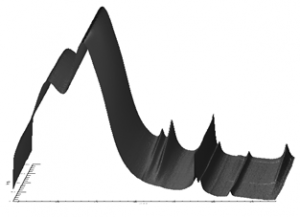 In situ studies give an opportunity to explore systems with a minimum of external interference. As Li-air batteries hold the promise for a future battery technology the investigation of the discharge and charge components of the cathode and anode is of importance, as these components may hold the key to making a large capacity rechargeable battery. Capillary batteries of Li-air have been developed for in situ XRD studies of the cathode. The battery design consist of a electrolyte filled capillary with anode and cathode in each end suspended on stainless steel wires, the oxygen in-let is placed on the cathode side of the capillary with a flushing system for oxygen in-let. In this study we present a flexible design of a capillary based Li-O2 battery with discharge and charge investigated in dimethxyethane (DME) with synchrotron XRD. The in situ study in these batteries show clearly how Li2O2 precipitates on the cathode side of the battery during discharge (see Figure 1), as the Li2O2 reflections at 21.2°, 22.5° and 37.1° grows. The reflection at 27.8°, 28.4° and 32.16° is from a stainless steel wire where the cathode is attached. The in situ XRD measurements show how the Li2O2 growth depend on current discharge rate and how the FWHM changes dependent on reflection and charge/discharge.
In situ studies give an opportunity to explore systems with a minimum of external interference. As Li-air batteries hold the promise for a future battery technology the investigation of the discharge and charge components of the cathode and anode is of importance, as these components may hold the key to making a large capacity rechargeable battery. Capillary batteries of Li-air have been developed for in situ XRD studies of the cathode. The battery design consist of a electrolyte filled capillary with anode and cathode in each end suspended on stainless steel wires, the oxygen in-let is placed on the cathode side of the capillary with a flushing system for oxygen in-let. In this study we present a flexible design of a capillary based Li-O2 battery with discharge and charge investigated in dimethxyethane (DME) with synchrotron XRD. The in situ study in these batteries show clearly how Li2O2 precipitates on the cathode side of the battery during discharge (see Figure 1), as the Li2O2 reflections at 21.2°, 22.5° and 37.1° grows. The reflection at 27.8°, 28.4° and 32.16° is from a stainless steel wire where the cathode is attached. The in situ XRD measurements show how the Li2O2 growth depend on current discharge rate and how the FWHM changes dependent on reflection and charge/discharge.
Several cells were tested both ex situ and in situ, and in situ XRD for 1st discharge/charge of the battery cell were measured, to give a better understanding of the electrochemistry in the Li-O2 battery.
